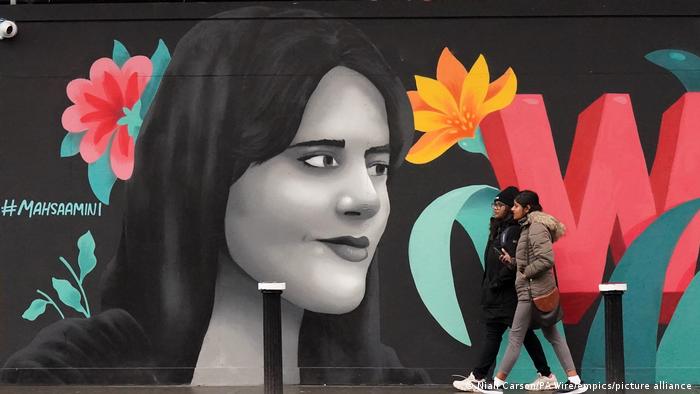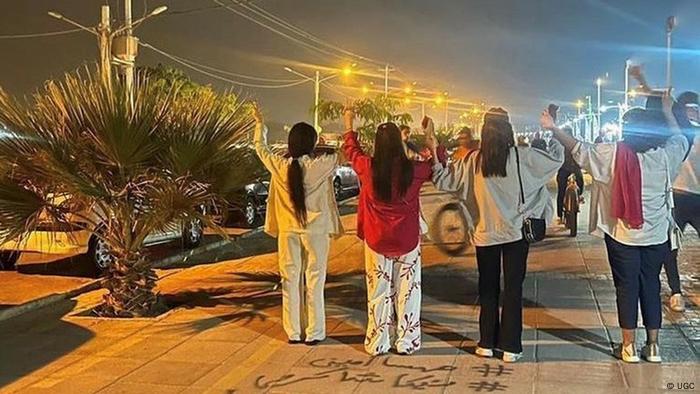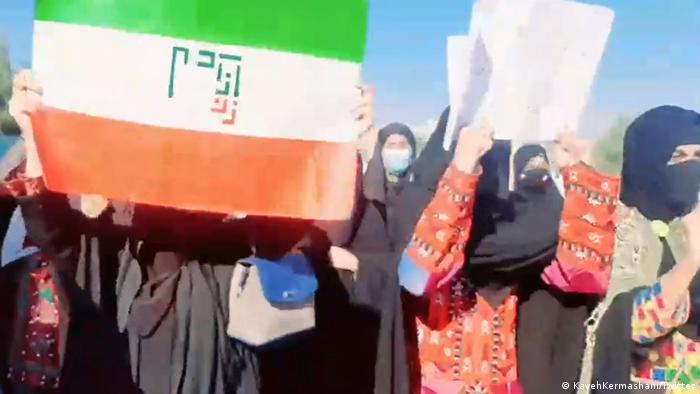The latest wave of protests in Iran was crushed with brutal violence. But courage to resist and solidarity have grown and can reignite the revolt at any time.

Mural depicting portrait of Jina Mahsa Amini in Dublin
The officials of the Islamic Republic emphasize in public that everything is under control. Ayatollah Ali Khamenei has even decided to pardon tens of thousands of prisoners, including many jailed for anti-government protests. It has not been officially announced how many demonstrators are in the country's overcrowded prisons. According to human rights organizations, more than 18,000 people had been arrested by mid-December for taking part in the nationwide protests. More than 500 protesters were killed, including at least 63 minors, mostly by shots in the head. The latest wave of protests was triggered by the death of the 22-year-old Iranian Kurd Jina Mahsa Amini in police custody in mid-September.

More than 18,000 protesters arrested by mid-December
Despite the violent suppression of the protests, they have continued for at least 100 days, writes the renowned social scientist Saeed Madani. His 44-page analysis was smuggled out of prison last week and published on social media. The 61-year-old professor from the University of Tehran has been behind bars since May 2022 because he said in an interview about the protests against inflation and food shortages: “These protests are against the entire political system and will come back.”
Now he writes: “The recent wave of protests, carried by different layers of society and ethnic and religious minorities, has left deep scars and changed society. The courage to resist and the solidarity among the oppressed across all generation have grown.”
Increased repression after the protests
“In the aftermath of such revolutionary phases or generally after phases of mass mobilization in autocratic regimes, repression often increases sharply,” Jannis Grimm told DW. Grimm, protest and revolution researcher at the Center for Interdisciplinary Peace and Conflict Research at Freie Universität Berlin. He points to the example of Egypt: “After the military coup in 2013, repression was ramped up massively in order to smash and nip any resistance in the bud. But this policy, in turn, already contains the seeds of potential headwind. Because autocrats are taking risks by deploying them of brutal repression always create new myths and martyrs. This in turn can provide the trigger for the next phase of mobilization.”
Such a phase of mobilization can be observed in the provinces of Sistan and Balochistan in south-eastern Iran. The provincial capital of Zahedan has developed into a stronghold of protests; the situation has been tense for five months. “The security forces are everywhere. At least 15 roadblocks have been set up in the city and the internet is still very restricted,” human rights activist Fariba Balouch told DW. Balouch, who has been living in exile in London for three years, is well connected in her hometown of Zahedan. She says: “Since the September 30 massacre, people have been protesting every Friday.”
Iran's leadership is cracking down on protesters
On that Friday at the end of September, more than 80 people were shot dead by the security forces in Zahedan over the course of several hours. They were partly stationed on the rooftops around the city's central mosque and opened fire on a crowd gathered in the streets after Friday prayers. The “bloody Friday” in Zahedan and the news, which was only announced with a delay because of the internet ban, shocked many Iranians nationwide.
Sustainable mobilization of women
Among those killed were small children and elderly women. For example, the seven-year-old Hasti Naroei, who accompanied her grandmother to Friday prayers. The bloody Friday mobilized many women in the traditionally conservative provinces of Sistan and Balochistan to join the protests, says Fariba Balouch. “Many women have burned their long black chadors and are now back in their traditional colorful dresses they wore up until the Islamic Revolution. Even religiously oriented women are showing solidarity at the Friday protests and supporting demands for equal rights for women in Iran.”
The protesters in the province are supported by the influential Sunni cleric Maulawi Abdulhamid, the Friday preacher in the provincial capital. Sunni Muslims are in the majority in the province, unlike the rest of the country. They suffer from systematic discrimination by the central government. The province on the border with Pakistan and Afghanistan is considered one of the poorest regions in Iran. Many believers who come for Friday prayer live in small towns and villages that have no schools, electricity or water supply. “Maulawi Abdulhamid rejected the government's offer in Tehran to pay money to appease the families of the demonstrators who were killed on September 30,” says Fariba Balouch. “People are demanding justice. They want freedom and a different political system and are shouting 'Death to dem.' Dictator'”.

“Woman, Life, Freedom”, hiwer printed on the Iranian flag, is also for religious women in Zahedan the motto of the time
Protests and protest actions continue not only in the provinces of Sistan and Balochistan. 1,800 kilometers away, in the Kurdish areas on the western border with Iraq, there are always protest meetings. Most recently on February 1st in the small town of Abdanan. There, the demonstrators had gathered in the city center and burned down a statue erected in honor of the Basij militias.
“Once the Wall of Fear has collapsed, it takes a very long time rebuilt,” says revolution researcher Grimm. Many people, especially women, are now putting up civil resistance. “For example, many women no longer wear headscarves,” writes Katajun Amirpur, a professor of Islamic studies with a focus on Iran, when asked by DW. “The main thing that has changed is that there is a greater sense of togetherness. This is reflected in the reputation: 'From Zahedan to Kurdistan, my heart belongs to Iran'. That is a very nice development.” The Iran expert from the University of Cologne is certain that the next wave of protests will come sooner or later.